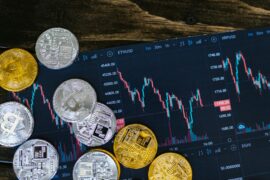This article may contain references to products or services from one or more of our advertisers or partners. We may receive compensation when you click on links to those products or services. Nonetheless, our opinions are our own.
Key Highlights
- Tangible assets are physical items with real, measurable value that can diversify your investment portfolio.
- Unlike intangible assets like intellectual property, tangible assets are concrete and often easier to evaluate.
- Examples include real estate, precious metals, commodities, and specific collectibles.
- Investors often favor tangible assets during economic uncertainty due to their inherent physical value.
- When investing in tangible assets, consider market conditions, storage requirements, and maintenance costs.
Introduction
Dreaming of a diverse investment portfolio? Investing in tangible assets could be crucial. These physical items—whether real estate, gold, or collectibles—offer stability and hedging benefits that many traditional financial assets cannot. But how exactly do they impact your portfolio, and why should you consider them? Let’s explore the value they bring to your financial strategy.
Understanding Tangible Assets in Your Portfolio
A strong investment portfolio thrives on diversity. While stocks and bonds dominate many portfolios, tangible assets provide unique advantages, particularly in volatile markets. Their physical nature can offer security that digital or paper investments might lack, appealing to investors seeking stability.
Defining Tangible Assets and Their Role
Tangible assets are physical objects with measurable value. They fall into two main categories:
- Fixed Assets: Long-term items like buildings, machinery, or equipment used in business operations.
- Current Assets: Items that can be converted into cash within a year, such as inventory.
These assets often act as a hedge against market volatility, providing stability in uncertain times.
Why Tangible Assets Matter
Tangible assets bring diversification and inflation protection to a portfolio. Unlike stocks, which can be highly sensitive to market sentiment, the value of tangible assets derives from their physical attributes and utility. This makes them less susceptible to sudden swings, offering steadier returns over time.
- Inflation Hedge: When inflation erodes currency value, tangible assets like gold or real estate often appreciate, preserving purchasing power.
- Reduced Volatility: The intrinsic value of tangible assets provides stability during economic downturns, making them a popular choice for risk-averse investors.
Comparing Tangible and Intangible Assets
Tangible and intangible assets each play distinct roles in investment strategies. Understanding their differences is crucial to building a balanced portfolio.
| Aspect | Tangible Assets | Intangible Assets |
|---|---|---|
| Physical Presence | Yes | No |
| Examples | Real estate, machinery | Patents, trademarks |
| Depreciation | Due to wear and tear | Due to obsolescence |
| Liquidity | Medium to low | Often high |
Tangible assets offer visible, measurable value, while intangible assets leverage intellectual or legal rights for growth.
Beginner’s Guide to Investing in Tangible Assets
Investing in tangible assets requires careful planning, research, and risk management. Here’s how to get started:
Step 1: Identify Valuable Tangible Assets
Choose assets aligned with your goals:
- For Growth: Real estate or high-demand commodities.
- For Stability: Precious metals like gold or silver.
- For Diversity: Collectibles or art pieces.
Step 2: Assess Market Value
Research recent sales of similar assets to determine fair market value. Consider:
- Cost Approach: Replacement value of the asset.
- Income Approach: Potential income generated by the asset.
Step 3: Understand Depreciation and Maintenance
Factor in depreciation and upkeep costs:
- Real estate requires repairs and upgrades.
- Machinery loses value over time.
- Art and collectibles need specialized storage to maintain condition.
Types of Tangible Assets for Diverse Portfolios
Real Estate
- Stability: Long-term value appreciation and rental income.
- Risks: Market cycles and maintenance costs.
Precious Metals
- Hedge Against Inflation: Gold and silver retain value during economic uncertainty.
- Volatility: Prices can fluctuate due to supply and demand dynamics.
Collectibles and Art
- Emotional and Monetary Value: Rare coins, vintage cars, or famous paintings can grow in worth.
- Challenges: Requires expert appraisal and careful buyer-seller matching.
Evaluating Risks and Returns
Risk Factors
- Market Volatility: Physical assets are not immune to price swings.
- Storage and Insurance: Costs can erode returns.
- Liquidity: Some assets, like rare collectibles, may take time to sell.
Risk Mitigation Strategies
- Diversify: Spread investments across asset types.
- Research: Understand demand and market trends.
- Insure: Protect assets from theft or damage.
Conclusion
Tangible assets offer a tangible (pun intended) way to diversify your investment portfolio, providing stability, inflation protection, and long-term growth potential. Whether you’re a seasoned investor or just starting out, incorporating physical assets into your financial plan can enhance your portfolio’s resilience and returns. Start small, research thoroughly, and enjoy the security of investing in the physical world.
Frequently Asked Questions
What Makes an Asset Tangible?
Tangible assets are physical, measurable items like real estate or machinery, as opposed to intangible assets like patents.
Can Tangible Assets Hedge Against Inflation?
Yes, tangible assets like gold and real estate often increase in value during inflationary periods, preserving your purchasing power.
What Are the Tax Implications?
Taxes depend on the asset type and use. Consult a tax advisor for guidance on depreciation and capital gains.
How Can I Start Investing with Limited Capital?
Begin with affordable options like fractional real estate or small collectibles, gradually building your portfolio.

Reviewed and edited by Albert Fang.
See a typo or want to suggest an edit/revision to the content? Use the comment form below for feedback.
At FangWallet, we value editorial integrity and open collaboration in curating quality content for readers to enjoy. Much appreciated for the assist.
Did you like our article and find it insightful? We encourage sharing the article link with family and friends to benefit as well - better yet, sharing on social media. Thank you for the support! 🍉
Article Title: Tangible Assets Meaning: How Physical Investments Impact Your Portfolio?
https://fangwallet.com/2025/04/28/tangible-assets-meaning/The FangWallet Promise
FangWallet is an editorially independent resource - founded on breaking down challenging financial concepts for anyone to understand since 2014. While we adhere to editorial integrity, note that this post may contain references to products from our partners.
The FangWallet promise is always to have your best interest in mind and be transparent and honest about the financial picture.
Become an Insider
Editorial Disclaimer: The editorial content on this page is not provided by any of the companies mentioned. The opinions expressed here are the author's alone.
The content of this website is for informational purposes only and does not represent investment advice, or an offer or solicitation to buy or sell any security, investment, or product. Investors are encouraged to do their own due diligence, and, if necessary, consult professional advising before making any investment decisions. Investing involves a high degree of risk, and financial losses may occur including the potential loss of principal.
Source Citation References:
+ Inspo











































